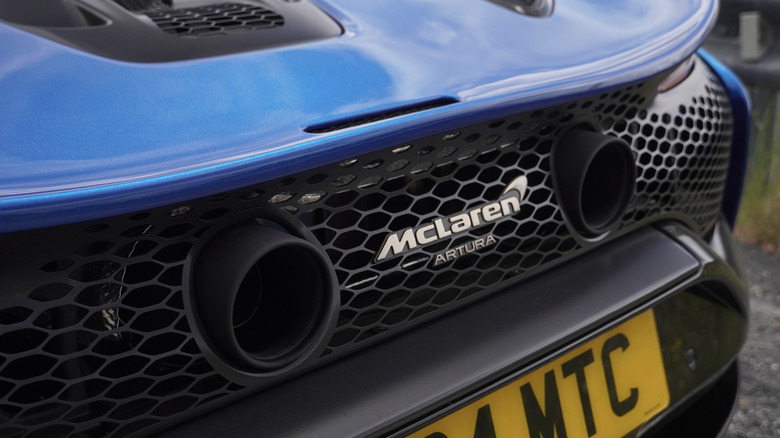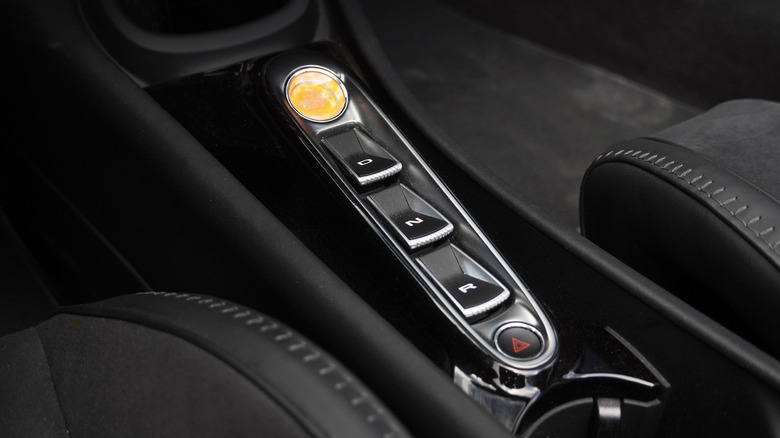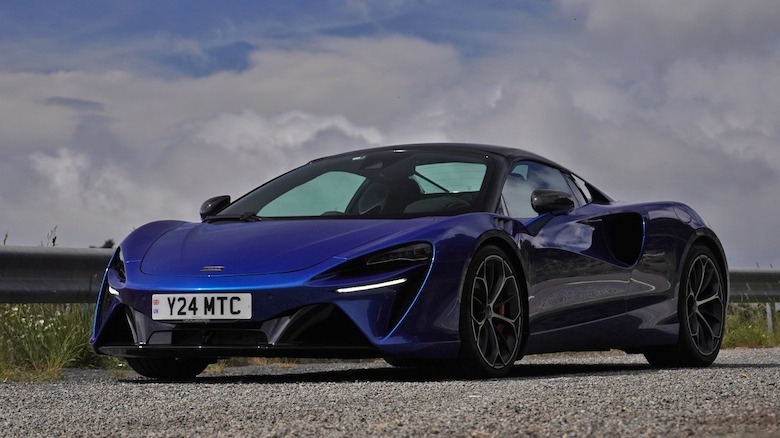2025 McLaren Artura Spider First Drive: Less Roof, More Money, Still A Surprise
Two years after the Artura debuted as McLaren's entry-level hybrid supercar, a Spider version now enters the lineup for model year 2025. Of course, McLaren developed the Artura chassis with a hardtop convertible variant in mind all along, but the later addition of the Spider simultaneously marks updates to the platform for additional performance, as well.
The new Spider and coupe will both bump total output up to 690 horsepower from the combined electric and turbocharged V6 drivetrain. Owners of previous coupes can also swing by a McLaren dealer to receive an ECU tune that will update older cars to the new specs. But the 2025 Arturas receive much more in addition to the power gains, though, so McLaren recently invited media to Monaco and southern France to experience the epitome of open-top motoring on some of the world's most recognizable roads.
Weight savings at center stage
After driving the Ferrari 296 GTS earlier this spring, against which McLaren clearly hopes to benchmark the Artura, I arrived very curious to experience the British take on hybrid supercar performance. Especially given that McLarens always prioritize weight savings and handling, rather than all-out straight-line speed—hence the repeated emphasis on the fact that the Artura Spider weighs 83 kilograms (183 pounds) less than the next lightest competitor (doing the math shows that to be the 296 GTS at 3,395 lbs). Even the sublime Maserati MC20 Cielo weighs more, despite the carbon-fiber monocoque and lacking hybrid components.
The Spider also adds only 136 pounds to the coupe's curb weight, too, by using eight electric motors for the retractable hardtop componentry (much of which carries over from the 750S Spider that I drove just a few months ago, as well). But the Artura differs from both the Ferrari and its 750S sibling in more than a few ways, even if the 296 GTS also employs a 120-degree V6 paired to an electric motor in the transmission bell housing to keep mass as lowslung in the chassis as possible.
Versus the Artura coupe, the Spider avoids using additional bracing, so the weight difference comes down to the deleted hardtop parts and adding the convertible components. To make up for the slight gain, McLaren then revised the programming for the valving of the suspension's adaptive dampers. Meanwhile, the ECU tune adds 19 horsepower and the DCT transmission now manages 25% quicker shifts by keeping the open clutch closer to the mesh point at all times. Stiffer engine mounts, 90% faster processing and new damper valve stacks, as well as new brake cooling ducts fit into the model year 2025 updates. There's even cooling for the retractable hardtop components.
Adjusting to the Artura
The presentation before McLaren handed our assembled crew of seasoned journalists the keys to any Artura Spiders gave us a lot of info to process while driving up the climb out of Monaco. I also immediately experienced the updated ADAS system, which uses a pleasing pitch of chime to warn against drifting over lanes in the road—something that happens often while trying not to curb supercar wheels on the narrow streets of Europe. I needed to activate the front-axle lift repeatedly to avoid scraping the front splitter on speed humps, too, though luckily the Artura will stay lifted at speeds up to 50 kph (31 mph) before dropping again.
Managing all the software and hardware via the Artura's dash switchgear and touchscreen proved fairly easy, since the automaker's latest models all carry forward the intuitive design and software themes that started on the 600LT and continued on the 750S (a welcome contrast to the more confusing 720S architecture).
Same, too, for the Handling and Performance toggles atop the gauge cluster—very familiar after the 750S—which I flipped through repeatedly. In Comfort mode for both, the Artura softens up enough to make driving a six-figure supercar surprisingly approachable. On the highways and city streets between Monaco and Nice, the Artura rode perhaps a tad stiffer than the 750S, with flatter dynamics and more feedback from tires traversing surface conditions. Soon enough, though, we turned up into the mountains and the chugging diesels of French traffic started to disperse. Time to flip into Sport, then Track modes, and get rowdy.
Power and performance upgrades for 2025
The first time I hit full throttle in the Artura Spider, I've got the Power in Track mode but the handling still set to Comfort. Even though the hybrid-V6 might lack some of the gut-punch of full EV performance, I can feel the small axial flux motor's 166 lb-ft of electric torque filling in at lower revs as the twin-turbos spool up and the suspension shifts rearward, creating more traction at the rear tires the harder the powertrain pulls. Up toward the 8,250-rpm redline, I pull on the righthand paddle and the Artura snaps into third gear with a snarl of the exhaust.
For a V6, the Artura sure sounds great. McLaren must know that six-cylinder engines other than those from Stuttgart tend to sound fairly banal, because the Artura now uses a symposer to route exhaust sounds from the rear muffler into the cockpit. Yes, I had to ask how that works. Essentially, a pipe comes off the muffler, with valves that control sound waves traveling to a dual-skin sort of speaker surface. No gas enters the passenger compartment, of course, just sound waves. So, no fake nor synthetic computerized soundtrack here, and yet the exhaust roar still never fully covers up the more enthralling rush and wail of spooling turbos, not even the mildly futuristic whine of the electric motor straining.
About more than straight-line speed
The combined power of a twin-turbo V6 with mild hybrid assist makes the Artura capable of a three-second sprint to 60 miles per hour—notably, that's regardless of coupe or Spider configuration because the main limitation isn't power-to-weight but instead, managing traction. In that regard, having 136 more pounds pushing down on the tires might actually help the Spider keep up with the coupe, though McLaren will admit the convertible version drops off a tenth of a second in the sprint to 200 kilometers per hour (124 mph). I'd call that difference negligible, and certainly less important than potentially swapping on a set of Michelins to replace the stock Pirelli P Zeros.
Power stats mean less and less these days, and even if the Artura Spider slots in as the lightest hybrid-V6 supercar on the market today, the dynamics still need to live up to McLaren's legendary history. Yet here I picked up on marked differences versus the sublime 750S. The Artura's steering, for one, requires a bit more muscle and yet, simultaneously, lacks quite the same level of precision. Maybe 10% more weight or the wheel-and-tire choice or a 1.1-inch shorter wheelbase—or a combination of the above, plus a different team working on Artura—make up for the minor difference.
Mindlessly left-foot braking out of nowhere
Similarly to the 750S, in Comfort mode the Artura can start to raft over the worst undulating portions of mountain roadway. Remember these cars lack sway bars, so I definitely needed to tighten up the handling to Sport in the hopes of battening down the peculiar sensation while ripping around in France. But I only tried out Track handling a couple of times because the chassis then firms up overboard, and the discomfort of jarring impacts started to ruin all the fun.
Maybe an hour and a half into the drive, on the famous road where Pierce Brosnan raced Famke Janssen and knocked down the line of cyclists early in Goldeneye, I realize that I've started left-foot braking without having consciously decided to do so. And therein lies one of McLaren's greatest secrets: brakes with a racecar level of pedal travel and feel. The 750S represented something of a departure from that trend, with carbon-ceramics that act more similar to a regular steel setup, but the Artura splits the gap and makes using the left foot even more fun, encouraging later, firmer application and even additional trail-braking through corners.
No regen in this hybrid supercar
Surprisingly, McLaren decided not to allow the Artura to use regenerative braking. Instead, the engine itself charges up the battery by lagging the electric motor. So where I first attributed some brake modulation lurching at crawling speeds in traffic to regen, I now believe the electric motor kicks in a little bit awkwardly when nearly stopped, just occasionally. And yet the brake pressure and performance while pushing hard therefore remains supremely consistent without regen, something of a worthy tradeoff and one that undoubtedly contributed to my mindless transition to left-foot braking.
Without regen, the Artura allows the driver to set a target for the battery's state of charge, other than in Track or full EV mode—in the former the e-motor always saps a bit of charging energy from the engine, while in the latter the engine switches off entirely. Setting the desired charge level requires flipping through a couple of screens on the smaller gauge cluster via a stalk on the steering wheel column, but dropping into EV mode takes just a toggle up above the gauges.
Playing with the little details
After the more technical driving portion of the day ended, I spent some time fiddling with the center touchscreen and steering wheel controls just to learn how to put every last bit of McLaren's tech to work. I cranked up the tunes in traffic—some George Michael on the Bowers & Wilkins speakers thanks to McLaren's pre-programmed playlist. Bowers & Wilkins added a small central speaker between the seatbacks to throw in extra high-frequency trebles with the roof down, though with the roof up the system truly bumps.
The center touchscreen functions similarly to a smartwatch, with a dial/button on the side for basic controls and switching between menus. The setup works quite well for dipping in and out of different screens for nav, media, and climate, while helping to eliminate excessive buttonry on the rest of the dash and center console. The fact that the touchscreen itself angles toward the driver, but is mounted not quite perfectly vertical, started to bug my OCD by the end of the day, though. I wanted to swivel it a bit to line up, like a painting hanging crooked on the wall.
2025 McLaren Artura Spider Verdict
Yet other nice little details started to stand out, too. The Artura Spider's visibility out the rear window is spectacular for a mid-engined hardtop convertible. The glazed glass of the buttresses makes less of a difference than McLaren maybe hopes, but then again, every little bit helps. And with the windows up, very little wind enters the cockpit thanks to advanced aerodynamics that keep the engine bay cool but also include a small Gurney wrinkle atop the windshield surround to optimize laminar flow.
The fact that everything works so well in such a compact package, with modern updates to help the Artura keep up with the competition, almost makes this supercar's daily drivability more impressive than the sheer weight savings. Clearly, putting in a couple of extra years to nail the Artura Spider without losing any of the quintessential McLaren identity paid off big dividends.
The performance, style, and tech all come together swimmingly, and even highly optioned at $338,900 as my Artura Spider arrived in Monaco, that price tag pales in comparison to a 296 GTS that can hit half-a-million with ease—though the Ferrari is undoubtedly a more aggressive, higher-concept car inside and out. I'm not a convertible guy, just generally speaking, and would probably still take an Artura in coupe form, but for those summer days when the old urge to run for the hills hits, the Artura Spider sure fits the bill.













